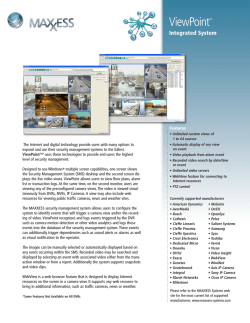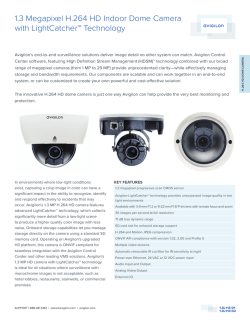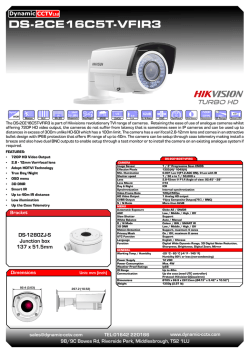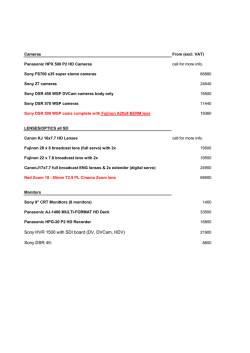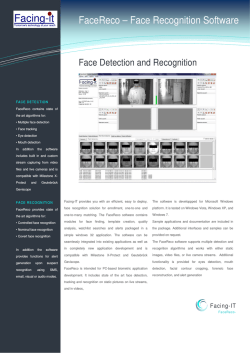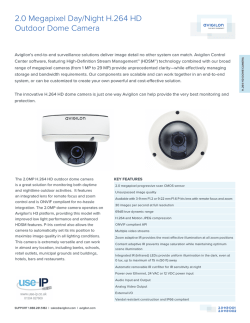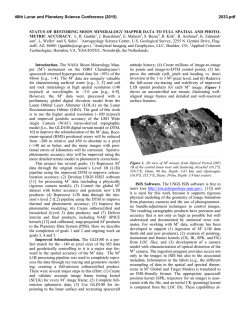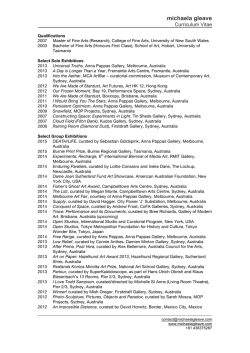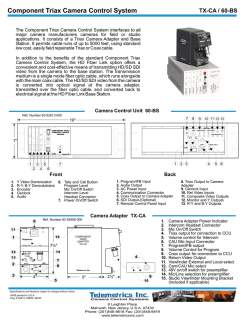
1693
46th Lunar and Planetary Science Conference (2015) 1693.pdf INITIAL RESULTS FROM THE DESERT FIREBALL NETWORK. M. C. Towner1, P. A. Bland1, M. C. Cupak1, R. M. Howie1, E. K. Sansom1, J. P. Paxman5, M. Inie5, M. Galloway6, G. Deacon2, K. A. Dyl1, G. K. Benedix1, S. J. Tingay3, J. A. Harrison4, A.W.R. Bevan2 Dept. Applied Geol., Curtin Univ., GPO Box U1987, Perth, WA 6845, Australia. E–mail: [email protected], 2 Dept. Earth Planet, Sci., Western Australian Museum, Welshpool, Perth,WA 6986. 3 Int. Centre for Radio Astron. Res., Curtin Univ., Perth, WA 6845, Australia. 4 iVEC, 26 Dick Perry Ave., Kensington, Perth, WA 6151, Australia. 5 Dept. Mech. Eng., Curtin Univ., Perth, WA 6845, Australia. 6 School Comp. Math., Univ. Western Australia, Perth, WA 6009, Australia. 1 Introduction: The Desert Fireball Network is a large network of cameras across the Australian outback, designed for recording meteor entry and recovering the associated meteorite. The outback offers excellent meteorite searching conditions compared to temperate zones, and the Australian climate provides many clear nights for good coverage. The current system is an evolution of the earlier trial film-based network[1], and now uses self-contained digital video and still cameras. Progress: To date, 30 cameras have been deployed, over South Australia and Western Australia, as shown in fig 1. Initial systems were deployed in early-mid 2014 on the Nullarbor plain, an area well known for meteorite finds. The second phase of expansion, from October 2014, was focused on South Australia, covering areas with large dry lakes, again good for searching. Other minor deployments have been in the WA wheatbelt, which is easy to support logistically from Perth, and is good searching for the fallow part of the year. System description: The hardware consists of a still camera (Nikon D800, Samyang 8mm fisheye), and a video camera (Watec 902H, Fujinon fisheye), supported by a single board PC and hard disks. A Liquid crystal shutter is incorporated into the lens, to act as a flickering shutter to breaks the fireball track in a long exposure, to permit calculation of the fireball velocity [2]. Internet link is provided by 3G mobile coverage, or LAN/Wifi, depending on deployment. A small solar power system is used for remote sites, or mains power if available. Fig 2 shows a typical camera system (at Mount Ives homestead), with camera mounted on a stand with a sunlight shield. Solar panels and battery are located directly next to the camera. Data pipeline: the network is supported by a mains server located in Perth, and access to the iVEC/Pawsey Centre HPC data store for large data storage. The still cameras record images every 30 seconds throughout the night, and process them during the day, searching for fireballs. Video is recorded throughout the night, and mostly deleted in the morning, unless a corresponding fireball is observed. The still images are processed on-board the camera system, such that only text files and occasional images are transferred to the main server, reducing the bandwidth requirements. All images are stored in the camera itself for later off-line retrieval (by hard disk swapping). The server correlates events seen by individual cameras, and attempts to triangulate them to give meteor trajectory solutions. Any plausible solutions are forwarded to an operator along with relevant images and fall mass/position estimates for further investigation. This automated pipeline reduces the manual intervention to a minimum, allowing a large network to be operated by only a few people. Initial statistics: commercial hardware performance is proving satisfactory for the requirements of the project. Out of 30 systems deployed for about 1 year, 2 systems have failed with mechanical shutter problems and have been replaced. The 2 oldest working systems currently have shutter counts of over 300,000 exposures. The network operates as a VPN on top of heterogeneous infrastructure, and there are frequent network dropouts with individual systems (usually the more remote systems running on 3G networks). Once connection is re-established, backlogged data is automatically transfered, and the server then re-checks for any new viable triangulations. At remote sites, solar power has been more reliable than mains, as brief power cuts are not uncommon in the outback, and these result in system re-boots. In future, solar will be preferred, or a UPS backup will be used. With the current network of 30 cameras, we record about 1 good triangulatable result every 1-2 weeks. Only some of these are meteorite dropping events. It is very likely that more fireballs have been recorded, but are not detected by the current generation of software deployed on the cameras. Once the hard disks are recovered, the data can be re-analyzed using newer tools. Geminids: over 14-15th December, the DFN cameras saw a marked increase in fireballs, with 3 double 46th Lunar and Planetary Science Conference (2015) station events recorded in one night, plus multiple single station events. See fig 3. Future: Several of the more remote camera systems have no internet link; data from those systems is added to the archive after expeditions to retrieve and replace the hard disks. (Event detection software is then re-applied to the new dataset in combination with other nearby cameras). New satellite modems are in testing to integrate these remote cameras to the realtime network. Additionally there will be further deployments of more camera systems, in New South Wales, South Australia and Western Australia. We expect to have over 50 deployed cameras by mid-late 2015, and approximately 60TB of archived all-sky imagery, available for analysis by interested researchers. 1693.pdf References: [1] Bland P.A. et al. 2012, Australian J. Earth Sci. 59:177-187. [2] Howie, R. M. et al, this conference (2015) Below: Figure 1; map of camera sites in Australia. Below left, Figure 2; deployed camera on stand with supporting solar panels. Below right, Figure 3; Gemind event recorded by camera at Yalgoo, in the WA wheatbelt
© Copyright 2025
